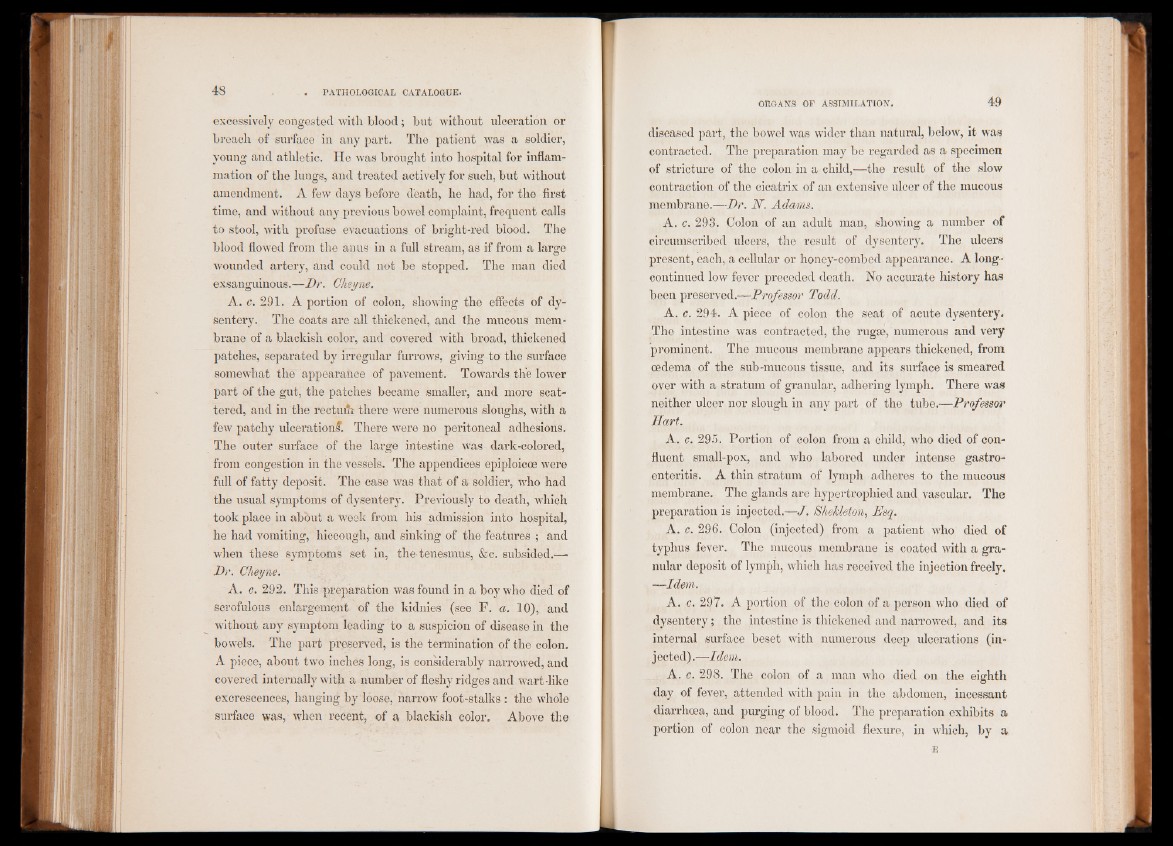
48 PATHOLOGICAL CATALOGUE.
excessively congested with blood; but without ulceration or
breach of surface in any part. The patient was a soldier,
young and athletic. He was brought into hospital for inflammation
of the lungs, and treated actively for such, but without
amendment. A few days before death, he had, for the first
time, and without any previous bowel complaint, frequent calls
to stool, with profuse evacuations of bright-red blood. The
blood flowed from the anus in a full stream, as if from a large
wounded artery, and could not be stopped. The man died
exsanguinous.—Dr. Cheyne.
A. c. 291. A portion of colon, showing the effeots of dysentery.
The coats are all thickened, and (he mucous membrane
of a blackish color, and covered with broad, thickened
patches, separated by irregular furrows, giving to the surface
somewhat the appearance of pavement. Towards the lower
part of the gut, the patches became smaller, and more scattered,
and in the rectiuti there were numerous sloughs, with a
few patchy ulcerations. There were no peritoneal adhesions.
The outer surface of the large intestine was dark-colored,
from congestion in the vessels. The appendices epiploicce were
full of fatty deposit. The case was that of a soldier, who had
the usual symptoms of dysentery. Previously to death, which
took place in about a week from his admission into hospital,
he had vomiting, hiccough, and sinking of the features ; and
when these symptoms set in, the tenesmus, &c. subsided.—
Dr. Cheyne.
A. c. 292. This preparation was found in a boy who died of
scrofulous enlargement of the kidnies (see F. a. 10), and
without any symptom leading to a suspicion of disease in the
bowels. The part preserved, is the termination of the colon.
A piece, about two inches long, is considerably narrowed, and
covered internally with a number of fleshy ridges and wart-like
excrescences, hanging by loose, narrow foot-stalks : the whole
surface was, when recent, of a blackish color. Above the
diseased part, the bowel was wider than natural, below, it was
contracted. The preparation may be regarded as a specimen
of stricture of the colon in a child,—the result of the slow
contraction of the cicatrix of an extensive ulcer of the mucous
membrane.— Dr. N. Adams.
A. c. 293. Colon of an adult man, showing a number of
circumscribed ulcers, the result of dysentery. The ulcers
present, each, a cellular or honey-combed appearance. A long-
continued low fever preceded death. No accurate history has
been preserved.—Professor Todd.
A. c. 294. A piece of colon the seat of acute dysentery.
The intestine was contracted, the rugae, numerous and very
prominent. The mucous membrane appears thickened, from
oedema of the sub-mucous tissue, and its surface is smeared
over with a stratum of granular, adhering lymph. There was
neither ulcer nor slough in any part of the tube.—Professor
Hart.
A. c. 295. Portion of colon from a child, who died of confluent
small-pox, and who labored under intense gastroenteritis.
A thin stratum of lymph adheres to the mucous
membrane. The glands are hypertrophied and vascular. The
preparation is injected.—J. SheJdeton, Hsq.
A. c. 296. Colon (injected) from a patient who died of
typhus fever. The mucous membrane is coated with a granular
deposit of lymph, which has received the injection freely.
■ ~-Idem.
A. c. 297. A portion of the colon of a person who died of
dysentery; the intestine is thickened and narrowed, and its
internal surface beset with numerous deep ulcerations (in-
j ected).—Idem.
A. c. 298. The colon of a man who died on the eighth
day of fever, attended with pain in the abdomen, incessant
diarrhoea, and purging of blood. The preparation exhibits a
portion of colon near the sigmoid flexure, in which, by a
E